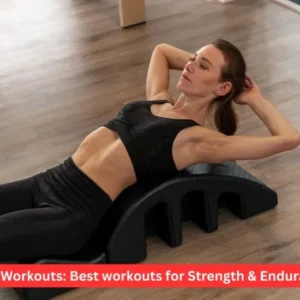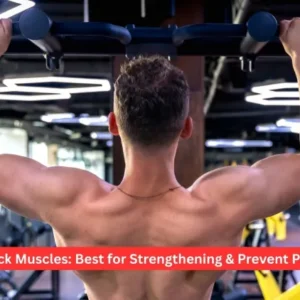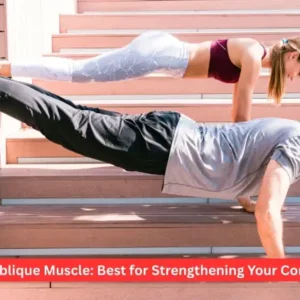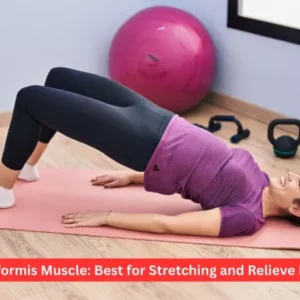Guys, the truth is that most people perform wrist curls incorrectly, setting themselves up for weak forearms.
If you’re doing reps without the proper grip, starting posture, or resistance, you’re wasting your time and risking injury.
It doesn’t matter if you’re doing a seated wrist curl, a standing wrist curl, or a single D-handle; how you set up affects whether this action improves grip strength or causes aching wrists.
Your choice of wrist curls and grip style (overhand, underhand, or even pronated grip) determines which muscles you’re targeting—forearm flexors or extensors.
Too heavy? You will lose form and strain your wrists.
Is it too lightweight? You are scarcely accomplishing anything.
Don’t think of wrist curls as just another throwaway upper body exercise.
When done correctly, this technique improves wrist flexibility, increasing total forearm strength and protecting against injury.
Let’s talk about how to do wrist curls correctly!
Wrist Curls: How Forearms Muscles Worked
Establishing the mind-muscle link is essential for getting the most out of wrist curl exercises, especially forearm training.
Whether doing a regular wrist curl, reverse wrist curl, or wrist extension, concentrating on your wrist flexors and forearm muscles promotes appropriate activation and maximum results.
These isolation exercises work both the wrist flexor and extensor muscles, making them vital for increasing grip and forearm strength.
For the best results, use weights corresponding to your fitness level and allow yourself to maintain a full range of motion while avoiding wrist strains or aching wrists.
From seated wrist curls on a flat bench to standing variations with handheld weights, appropriate body alignment and steady motion are essential.
The proper grip on weights—underhand, overhand, or supinated—ensures that your forearm workouts result in a firm grip and well-developed forearm muscles.
Begin with lesser weights to build a strong comfort level, then progressively advance to higher weights as your strength improves.
The wrist curl exercise works for the following key muscle groups.
FLEXORS
The wrist flexors are the key muscles responsible for the wrist curl.
These muscles on the underside of the forearm are crucial for flexing the wrist, curling the weight toward your body, and producing the desired forearm burn.
Strong flexors boost grip strength and increase the thickness of your forearm, giving you a robust appearance.
EXTENSORS
On the other hand, the wrist extensors are essential for wrist stability and strength, particularly during reverse wrist curls.
Extensor muscles cooperate synergistically to extend the wrist and resist weight, balancing forearm development.
They keep your wrists from buckling under pressure, ensuring every repetition counts.
BRACHIORADIALIS
In terms of forearm aesthetics, the brachioradialis is the most prominent feature.
This muscle, located on the top of your forearm, works hard during reverse curls and wrist extensions to increase size and definition.
It bridges the distance between your biceps and forearm muscles, allowing you to flex the elbow and stabilize the wrist during heavy lifts.
If you want attention-grabbing forearms, don’t ignore this muscle.
How to do wrist curls Properly
Mastering the starting posture is critical to getting the most out of wrist curls and developing considerable upper-body strength.
You can use handles, a resistance band, or weight plates, but your configuration dictates how effectively you target the wrist extensor muscles while avoiding injury.
Here’s how to improve your wrist curl technique:
WRIST CURL
How to Do the Wrist Curl:
- Stand erect and grab a dumbbell or barbell with your hands up and your knuckles facing the floor. Keep your core strong and let your arms dangle naturally in front of you.
- From here, keep your elbows locked at your sides and curl the weight up by flexing your wrists. Concentrate on tightening your forearm muscles at the top, where the growth occurs.
- Slowly lower the weight back down steadily, allowing your wrists to fully extend for the deep stretch.
- Repeat for the desired number of repetitions, keeping the movement to your wrists. Don’t allow your elbows to stray or your shoulders to take control.
What Makes It Effective: This movement increases the tension in your forearms and keeps your wrists in the ideal position to manage the load, ensuring that the work stays on your forearms rather than your upper body.
BACKPACK CLASSIC WRIST CURL
How to do the Backpack Classic Wrist Curl:
- Take a sitting position with your elbow resting on the knee.
- Grab the backpack by the top handle with an underhand grip, keeping your forearm bent and ready to curl.
- Curl your wrist up, bringing the handle into contact with your forearm as you squeeze at the top.
- Return to the starting position with complete control, then repeat.
What Makes It Effective: Resting your elbow on your knee keeps the backpack off the ground and provides the ideal selection of weights for constant stress. This configuration increases forearm engagement and is an excellent step for serious forearm growth, even if you don’t have access to a complete gym.
PRONE WRIST CURL
How to Do Prone Wrist Curls:
- In the starting position, grab a cable handle attachment at shoulder height with an overhand grip, palms facing away. This configuration ensures that you strike the wrist extensor muscles strongly.
- Bend your elbow slightly to keep your biceps out of the motion.
- Flex your wrist forward and then return to neutral in a controlled manner. The trick is to ensure that the contraction occurs in the forearm, not the upper arm.
- No cable machine? Not an issue. Replace it with a resistance band to achieve the same results.
- This single-joint resistance exercise works well with bands and classic weight training routines using weight plates.
What Makes It Effective: This variation causes a more muscular contraction in the extensor muscles, removing the biceps from the equation. The prone wrist curl is your best option if you’re looking for a vein map. Whether seated or standing, this exercise focuses on your forearms for maximal pump and vascularity.
BACKPACK EXTENSOR WRIST CURL
How to do backpack extensor wrist curls?
- With your elbow on your knee, grab the top handle of the backpack with an overhand grip. Ensure your hand is fully extended and your wrist is ready to move.
- Curl the backpack by lifting your hand back and concentrating on the wrist extensors. Maintain control and bring the handle into touch with your forearm at the top.
- Lower slowly back to the starting position and repeat, maintaining muscle tension throughout the movement.
What Makes It Effective: By elevating your elbow on your knee, you create just enough height to challenge your forearm extensors and encourage maximal growth. It’s a simple motion, but it produces serious effects by isolating the muscle to resemble more sophisticated sets without using a shoulder-height bench or other equipment.
WRIST CURLS: COMMON MISTAKES
If you’re not seeing the forearm growth you want, you’re probably making one of these wrist curl blunders.
Let’s break each one down so you can repair it and start receiving the results you want.
Correct these errors; you’ll witness superior forearm development, increased grip strength, and wrist stability.
Stop cheating on reps and start training as if you mean it!
USING YOUR SHOULDERS AND ELBOWS
Allowing your elbows to stray or shrug during wrist curls is a common problem.
This releases tension in your forearms and transfers it to your upper body.
Remember that your shoulders and elbows should remain perfectly motionless.
Lock your elbows against your thighs, whether seated on a bench with your knees at 90 degrees or standing.
Keep your shoulders relaxed, and let your forearms do all the work.
SPEEDING THROUGH REPS
Rushing through wrist curls wastes effort.
When you bounce the weight up and down, you rely on momentum rather than muscular contraction.
Slow down.
Significant gains are achieved when you have perfect control over every part of the movement.
Squeeze at the top to defy gravity and lessen the weight. At the end of each set, your forearms should be burning.
IMPROPER SETUP
How you set up your wrist curl is more important than you realize.
If seated, ensure your knees are bent at a 90-degree angle and your thighs support your forearms entirely.
Your wrists should hang slightly past your knees, not far forward or back.
This allows for a full range of motion while minimizing pressure on your wrists.
Keep your arms by your sides and your wrists positioned for maximum control if standing.
OVERLOADING WITH TOO MUCH WEIGHT
Ego-lifting is a significant issue with wrist curls.
Attempting to lift more weight than you can handle impairs form and increases your chance of injury.
Instead of focusing on how heavy you can lift, consider quality reps.
Select a weight that allows you to move over the entire range of motion while retaining control.
Remember that it’s preferable to feel the muscle functioning with lesser weights than to suffer through poor reps with bigger ones.
IGNORING THE NEGATIVE
Most lifters focus solely on curling the weight up and then letting it drop back down with no control.
That was a huge error!
The lowering phase (negative) is equally significant as the lift.
Slowly drop the weight, keeping your forearms tense throughout.
This will optimize muscle engagement and speed up your growth. Accept the burn—this is where the magic occurs!
Summary
Building forearm strength, grip, and wrist stability calls for wrist curls. For their execution:
- Chest up, stand with feet shoulder-width apart, then grab a dumbbell or barbell with palms facing up.
- Maintain your elbows by your sides, and use your core for support.
- Using just your wrists, curl the weight to compress the forearms at the top.
- Over the eccentric period, gradually reduce the weight for a deep stretch.
- Strictly keep the movement, isolating the wrists; eliminate swinging or shoulder movement.
This workout targets forearm muscles for development and injury prevention.
WRIST CURLS FAQS
WHAT ARE WRIST CURLS GOOD FOR?
Wrist curls are one of the most overlooked workouts for enhancing forearm strength, grip, and wrist stability.
Wrist curls are a wonderful workout to practice to achieve a strong, veiny appearance or lift more weight without losing grip.
They focus on the wrist flexors (palms up) and extensors (palms down), essential for overall forearm development.
Wrist curls not only look good, but they also serve to protect your wrists from injury.
More muscular forearms and wrists result in improved control and a lower chance of strains when performing heavier exercises such as deadlifts, rows, and presses.
Furthermore, they’re essential for sports and activities that require a firm grip, such as climbing, wrestling, or lifting heavy grocery bags.
So, if you skip wrist curls, you’re missing out on an essential component of strength training. Add them to your routine, and watch your forearm game improve.
DO WRIST CURLS BUILD MASS?
Absolutely—but only if you do them correctly.
Wrist curls are a great technique to build considerable forearm bulk, but you must train them with intention.
Don’t expect to see any progress if you’re flinging weight around with poor form.
To grow size, you must perform controlled reps with a full range of motion and maintain sustained muscular tension.
Wrist curls primarily target the wrist flexors (palms up) and extensors (palms down), responsible for your forearms’ robust, dense appearance.
The trick is to prioritize quality over quantity.
Slow down the repetitions, feel the muscle contract, and remember to regulate the negative (lowering phase). This is where the gains occur.
Remember, wrist curls alone will not result in gigantic forearms.
Combine them with other complex lifts with heavy grips, such as deadlifts, farmer’s carries, and rows, to achieve maximum growth.
When you master these concepts, your forearms will thicken and strengthen.
SHOULD I DO WRIST CURLS OR REVERSE WRIST CURLS?
What is the genuine answer? You should do both.
Regular wrist curls work the wrist flexors (muscles on the underside of your forearms), essential for increasing size and strength.
However, if you neglect reverse wrist curls, you will lose half of your forearm development.
Reverse wrist engage the wrist extensors (the muscles on top of your forearms), balancing your grip strength and generating a thick forearm appearance.
If you only hammer wrist and ignore the reverse, you’ll wind up with imbalanced forearms, leading to weak areas and injuries in the future.
Furthermore, balanced strength in your flexors and extensors improves everything from lifting performance to avoiding wrist problems.
Bottom line: Do not choose one above the other. Incorporate them into your program to maximize forearm growth and strength.








4 thoughts on “How To Do Wrist Curls in a Correct Way”
I have been exploring for a little for any high-quality articles or blog posts on this kind of space . Exploring in Yahoo I eventually stumbled upon this website. Studying this information So i’m glad to express that I’ve a very excellent uncanny feeling I came upon exactly what I needed. I such a lot without a doubt will make sure to do not overlook this site and provides it a glance on a continuing basis.
I am regular visitor, how are you everybody? This paragraph posted at this website is in fact pleasant.
When I initially commented I clicked the “Notify me when new comments are added” checkbox and now each time a comment is added I get several emails with the same comment. Is there any way you can remove people from that service? Many thanks!
Thanks for letting me know! I’ll look into the notification settings and remove you from the list so you won’t receive duplicate emails anymore.